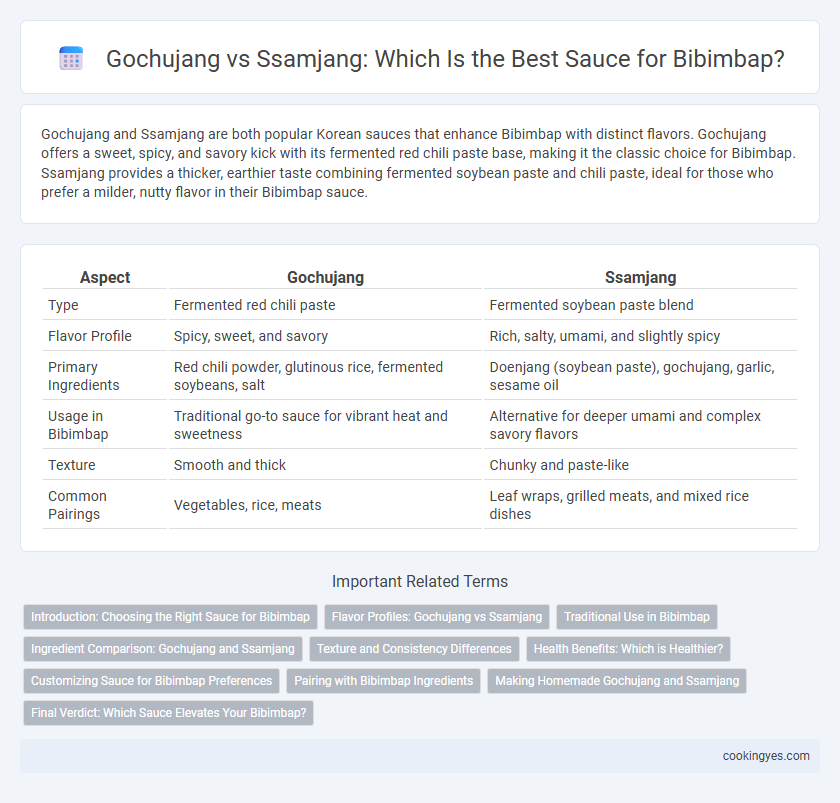Gochujang and Ssamjang are both popular Korean sauces that enhance Bibimbap with distinct flavors. Gochujang offers a sweet, spicy, and savory kick with its fermented red chili paste base, making it the classic choice for Bibimbap. Ssamjang provides a thicker, earthier taste combining fermented soybean paste and chili paste, ideal for those who prefer a milder, nutty flavor in their Bibimbap sauce.
Table of Comparison
| Aspect | Gochujang | Ssamjang |
|---|---|---|
| Type | Fermented red chili paste | Fermented soybean paste blend |
| Flavor Profile | Spicy, sweet, and savory | Rich, salty, umami, and slightly spicy |
| Primary Ingredients | Red chili powder, glutinous rice, fermented soybeans, salt | Doenjang (soybean paste), gochujang, garlic, sesame oil |
| Usage in Bibimbap | Traditional go-to sauce for vibrant heat and sweetness | Alternative for deeper umami and complex savory flavors |
| Texture | Smooth and thick | Chunky and paste-like |
| Common Pairings | Vegetables, rice, meats | Leaf wraps, grilled meats, and mixed rice dishes |
Introduction: Choosing the Right Sauce for Bibimbap
Gochujang is the traditional spicy-sweet red chili paste crucial for authentic Bibimbap, offering a rich umami flavor that enhances the dish's complexity. Ssamjang, a thicker soybean paste blend, provides a savory, nutty profile with a milder heat, making it a versatile alternative for those seeking a less fiery option. Selecting between Gochujang and Ssamjang depends on desired spice intensity and flavor depth, shaping the overall taste experience of Bibimbap.
Flavor Profiles: Gochujang vs Ssamjang
Gochujang offers a rich, spicy-sweet flavor with fermented chili pepper paste, balanced by a subtle umami depth that complements the mixed vegetables and rice in bibimbap. Ssamjang combines fermented soybean paste with chili, garlic, and sesame, delivering a more robust, savory, and slightly nutty taste that adds complexity and earthiness to bibimbap. Both sauces enhance bibimbap uniquely, with gochujang emphasizing spicy sweetness and ssamjang offering a deeper, savory intensity.
Traditional Use in Bibimbap
Gochujang is the traditional choice for Bibimbap sauce, renowned for its balanced blend of spicy, sweet, and savory flavors that enhance the dish's mixed vegetables and rice. Ssamjang, typically used as a dipping sauce for Korean BBQ wraps, is less common in Bibimbap and has a thicker, chunkier texture with a more pronounced fermented soybean flavor. The authentic experience of Bibimbap emphasizes gochujang's smooth consistency and flavor profile, which melds seamlessly with the warm ingredients of the bowl.
Ingredient Comparison: Gochujang and Ssamjang
Gochujang, a fermented red chili paste made from chili powder, glutinous rice, fermented soybeans, and salt, delivers a sweet, spicy, and savory profile essential in traditional Bibimbap sauces. Ssamjang combines fermented soybean paste (doenjang), chili paste (gochujang), garlic, sesame oil, and sometimes sugar, offering a robust umami flavor with a thicker, chunkier texture ideal for dipping or adding depth to Bibimbap. The key difference lies in gochujang's sweetness and heat balance versus ssamjang's earthier, richer taste profile with added garlic and sesame nuances.
Texture and Consistency Differences
Gochujang in Bibimbap offers a thick, smooth, and sticky texture that coats ingredients evenly, creating a bold and cohesive flavor profile. Ssamjang presents a chunkier, grainier consistency with bits of fermented soybeans and chili paste, providing a heartier, more textured bite. The creamy smoothness of Gochujang contrasts with Ssamjang's rustic texture, significantly influencing the mouthfeel and sauce distribution in Bibimbap.
Health Benefits: Which is Healthier?
Gochujang and Ssamjang both offer unique health benefits when used as Bibimbap sauces, but Gochujang, made primarily from fermented red chili paste, contains capsaicin which boosts metabolism and supports weight loss. Ssamjang, a blend of fermented soybean paste and chili paste, provides higher protein and probiotics that promote gut health and digestion. Choosing between the two depends on whether you prioritize metabolic benefits from Gochujang or digestive health from the probiotic-rich Ssamjang.
Customizing Sauce for Bibimbap Preferences
Gochujang offers a sweet and spicy flavor that enhances the authentic taste of bibimbap, making it ideal for those who prefer a bold and tangy sauce. Ssamjang, combining fermented soybean paste and chili, provides a deeper umami and savory richness, perfect for those seeking a more complex and earthy profile. Customizing bibimbap sauce with either gochujang or ssamjang allows diners to tailor the dish's flavor intensity and depth according to their personal preferences.
Pairing with Bibimbap Ingredients
Gochujang, a fermented red chili paste, complements Bibimbap's mixed vegetables and rice by adding a sweet-spicy depth that enhances the umami of ingredients like sauteed spinach, mushrooms, and zucchini. Ssamjang, a savory blend of fermented soybean paste and chili, pairs well with Bibimbap's protein elements such as grilled beef or tofu, providing a richer, earthier flavor that balances the freshness of raw vegetables. Both sauces elevate Bibimbap by highlighting different components: Gochujang intensifies the overall harmony with its vibrant heat while Ssamjang adds complexity and a bold savory note.
Making Homemade Gochujang and Ssamjang
Making homemade gochujang involves fermenting red chili powder, glutinous rice, fermented soybean powder, and malt barley syrup for several months, resulting in a sweet and spicy paste with deep umami flavor ideal for bibimbap. In contrast, ssamjang combines soybean paste (doenjang), gochujang, garlic, sesame oil, and chopped green onions, offering a thicker, nuttier, and less sweet sauce that complements the mixed vegetables and rice in bibimbap. Both sauces enhance bibimbap uniquely; gochujang delivers a bold heat and sweetness, while ssamjang provides a savory richness with a hint of earthiness, making their homemade preparation essential for authentic flavor profiles.
Final Verdict: Which Sauce Elevates Your Bibimbap?
Gochujang, a fermented red chili paste, offers a rich, spicy-sweet flavor that deeply enhances the harmony of bibimbap's mixed ingredients, providing a signature Korean taste. Ssamjang combines soybean paste with chili paste, yielding a savory, umami-rich profile that adds depth and earthiness but can sometimes overshadow the freshness of vegetables. For those seeking the classic, vibrant bibimbap experience, gochujang is the preferred sauce, while ssamjang serves well for a bolder, heartier variation.
Gochujang vs Ssamjang for Bibimbap sauce Infographic

 cookingyes.com
cookingyes.com